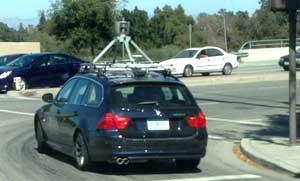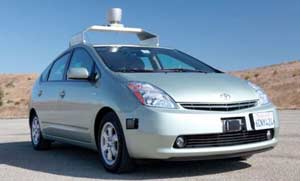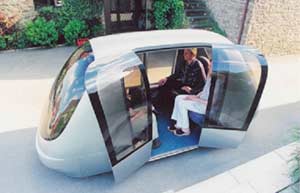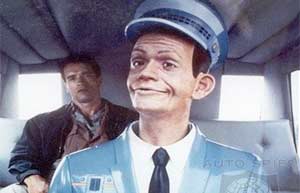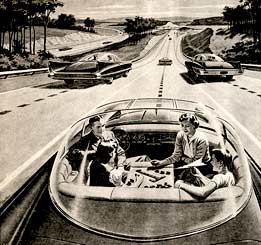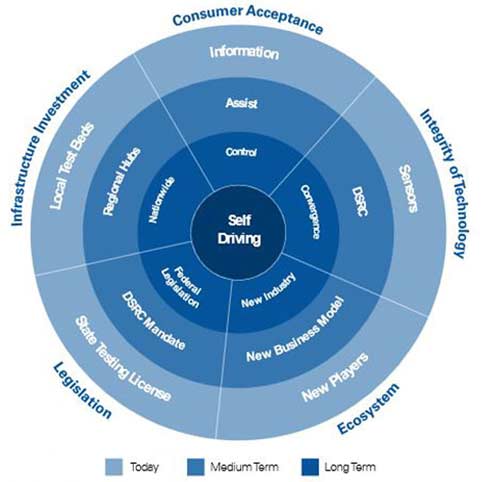Destinare is a Latin word meaning “make firm, establish” and is the basis for the both “destiny” and “destination”.
Destination in its original sense was the action of intending someone or something for a purpose;
later it meant being destined for a place, hence (from the early 19th century) the place itself.
Destiny is events that necessarily happen to a particular person or thing in the future or, more clearly,
a hidden power believed to control what happens in the future; fate.
So destination is the goal and destiny is what happens to you on the way there?
Meet the Self-Driving Cars
It’s been 100 years since mass-produced cars were born. A century later, as emerging markets grow richer, legions of new consumers clamour for their first set of wheels. For the whole world to catch up with current American levels of car ownership, the global fleet will quadruple. Even a fraction of that growth presents fearsome challenges (congestion, price of fuel, pollution, global warming, intangibles). The average American commuter spends 250 hours a year behind the wheel of a vehicle; whether the value of that time is measured in lost productivity, lost time pursuing other interests, or lost serenity, that cost is high. Today, those commuters inch along during rush hour traffic; they drive in circles around city streets looking for parking; in congested urban areas much gasoline is wasted by cars seeking parking. Parking lots and garages form urban dead zones, draining vitality from city streets. In some US cities, parking lots cover a third of the land area, in some cases the single most salient landscape feature of our built environment.
Where do we go from here?
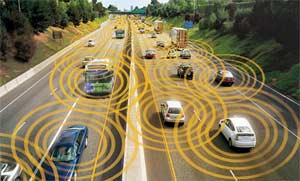
Volvo’s Traffic Jam Assist
- Perched atop the car sits a rack holding a sensor array. The component sitting highest is likely a LIDAR sensor, which uses lasers to paint a 3D picture of the car’s environment. Sitting lower is an industrial-grade GPS antenna, essential for telling the car’s computer where it is in the world.
- Wi-Fi Direct can be integrated with sensor-based object-detection and driver-alert systems that are already available on production vehicles. Development of vehicle-to-infrastructure (V2I) and vehicle-to-vehicle (V2V) communication systems provides advance warning about hazards (slowed / stalled vehicles, slippery roads, intersections, stop signs).
- There were around 32,000 US deaths in 2011 due to car accidents and 5.5 billion hours wasted due to being stuck in traffic. 1.2 million people world-wide died last year in traffic. Can really good maps can help with that? Apparently.
Numerous major companies and research organisations have developed working prototype autonomous vehicles, including Mercedes-Benz, General Motors, Google, Continental Automotive Systems, Autoliv Incorporated, Bosch, Nissan, Toyota, Audi, and Oxford University. A variety of “driver assistance” technologies have appeared on (expensive) new cars, which not only take a lot of the stress out of driving in traffic but also prevent many accidents. More and more new cars can reverse-park, read traffic signs, maintain a safe distance in steady traffic and brake automatically to avoid crashes. Some car makers promise technology that detects pedestrians and cyclists, overruling the driver, even stopping the vehicle before it hits them. A number of firms, including Google, are taking driver assistance to its logical conclusion by creating cars that drive themselves to a chosen destination without a human at the controls. And this is where it gets exciting. If and when cars go completely driverless — for those who want this — the benefits will be enormous.
The problems of the world cannot possibly be solved by skeptics or cynics whose horizons are limited by the obvious realities.
We need men who can dream of things that never were.
— John F Kennedy
How Do You Feel about Them?
Do you have a fear of flying? Even a small one that you’re (mostly) able to hide? Then you may have a fear of driverless cars — because the same fear (that of losing control) could manifest itself in a similar way with autonomous vehicles. But you needn’t be concerned just yet. Maybe in 5 years. Or 7. (10 at the outside…)
It’s natural that people are nervous about self-driving cars. Horseless carriages, as the first cars were called, took time to be accepted. Consider this account of a first drive, from a magazine called The Horseless Age, in 1897:
“There’s a sense of incompleteness about it. You seem to be sitting on the end of a huge pushcart, propelled by an invisible force and guided by a hidden hand. There’s also a seeming brazenness to the whole performance. I dreamt once that I walked down Fifth Avenue in my pajamas in the full tide of the afternoon promenade, and almost died with shame before I awoke. Yesterday I had something of the same feeling as I sat there and felt myself pushed forward into the very face of a grinning, staring, sometimes jeering New York. But it wore away after a while. Gradually I felt that I didn’t need the protection of a horse in front of me.”
The same issue of that magazine included a report of a Massachusetts law legalising the horseless carriage, but only if “so constructed and its novelties so covered and hid as not to be liable to frighten horses on the highway by its novel appearance.” An editorial criticised this as over-regulation: “Bicycles, locomotives, wheelbarrows, brass bands and 100 other things have frightened horses and brought death to many, but we don’t, on that account, banish those things from the streets.” (There. That’s pretty much where this post is going. Progress marches on. But not everything is entirely settled.)
Driverless cars are poised to become the next big thing. Google driverless cars in California have logged more than 500,000 miles with barely an incident (none due to a “driverless” driver). US states of California, Nevada and Florida have passed special laws allowing self-driving cars. More states (and laws) will follow. Under Nevada’s law, anyone operating a “driverless” car (unlike regular drivers) is allowed to text but isn’t allowed to drink alcohol (meaning that Nevada thinks self-driving cars should allow people freedom to not pay attention — but not have the freedom after a few drinks to decide that they’d rather do the driving themselves). The US federal agency that regulates car safety recently issued new guidelines for automated vehicles; standards to improve safety will come soon.
Elon Musk is a South African-American inventor and entrepreneur best known for founding SpaceX and co-founding Tesla Motors and PayPal. He doesn’t much care for the phrase “self-driving car.” Instead, he seems to prefer “autopilot.” While it might seem like trivial semantics, he says this makes clear that this technology is intended as a tool for drivers — not a replacement. For safety and liability purposes, he says a human still needs to be paying attention when these cars hit the market. He says don’t expect to be able to play Draw Something on your phone, or take a nap on the way to work. But Sergey Brin disagrees. He says completely driverless cars will be available within 5 years. Renault-Nissan’s boss says it’s more like 7. The problem is that for driverless cars to work, every inch of road, every junction, road sign, and signal everywhere will need to be mapped in perfect detail. (I’m not sure how they will keep up with changes.) This is being done anyway to support navigation systems for both cars and smartphones. Too much benefit accrues to ignore. Driverless cars are a done deal.
In Ann Arbor, near Detroit, 2,800 cars, lorries and buses have been fitted with devices to send and receive alerts. Some have a simple beacon informing of their location, speed and direction. Others have more elaborate kit that detects when another wired-up car out of sight around the next bend has slammed on its brakes. Human drivers today receive and act on alerts. In the future cars will respond automatically.
Governments want to ensure all road traffic is connected (among other benefits this reduces accidents, congestion, and theft). A transmitting beacon on every car would be good for dynamic road pricing, with charges depending on the type of vehicle and the time of day (an equitable “user pays” system). Brazil’s government is already preparing legislation requiring all cars to broadcast their make, model, registration number, age, fuel and engine power. Oops. Individual privacy retreats again. But it’s possible that individual privacy is threatened less by collecting public location information and more by the fact that information is aggregated. Current laws may not be equipped to adequately address new technologies and the growing data industry. Large-scale data mining and analytics techniques have been highlighted in newspaper headlines of late, stirring much concern over the power of aggregation and analytics. Consumer and privacy advocates already call for more transparency among data brokers, requesting that data collected, how, who has it, and how it’s used be made accessible.
But I get ahead of myself.
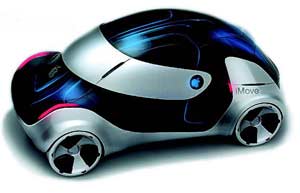
If Apple Made a Driverless Car…
Google gave a taste of the future by putting a blind man in a prototype and filming him being driven off to buy takeaway tacos. Huge numbers of elderly and disabled people could regain their personal mobility. The young won’t have to pay crippling motor insurance because their reckless hands and feet will no longer touch steering wheel or accelerator. The colossal toll of deaths and injuries from road accidents (plus another 2 million hospital visits a year in America alone) should tumble downward — along with costs to health systems and insurers. A driverless car would let a commuter use a laptop productively; commute time will effectively be office time. That will have a major impact on all sorts of things — housing prices in suburbia, for example. If you can commute for an extra hour, but use the time productively and get paid for it, then why wouldn’t you?
Driverless-car technology is projected to become a multi-multi-billion dollar industry. These cars ease congestion and save fuel, brake faster, sense when cars ahead brake (thus allowing them to drive closer to each other than humans can). On motorways, they can form fuel-efficient “road trains”, gliding along in the slipstream of the vehicle in front. Meanwhile, people who commute by car will gain hours each week to work (or to rest, socialise, or read).
Incumbent players rarely do well when industries disrupt. So if you work for an auto manufacturer (even remotely), you may be adversely affected. The same if you drive a truck, van, bus or taxi. The greatest obstacle to driverless cars may well be taxi drivers as over time more than 232,000 taxi and limo drivers in the US alone will lose their jobs. Also, more than 647,000 bus drivers and 125,000 truck drivers will be looking for new careers. Other jobs affected will include jobs at gas stations, parking lots, car washes, traffic cops, traffic courts, doctors, nurses, pizza delivery, mail delivery, FedEx, UPS, and possibly vehicle manufacturing positions (because the number of vehicles sold could decline — but on the other hand, it could even increase because everyone in the family may want their own private car, even children and the elderly who currently don’t drive).
Where Are We Today?
In reality, driverless technology slowly migrates into new vehicles through features such as automated braking (should your car get too close to the car ahead), adaptive cruise control (its speed is based on surrounding traffic), self-parking systems (slow, maybe, but safe), and lane-departure warning systems (it senses markers). These systems are pricey today and available mostly only on luxury cars (but that will likely change).
Cars become driverless in stages as new software stitches together various automated systems. One North American engineer (who oversees automated vehicle programmes for a major player) foresees that by 2016 partially automated cars will brake and steer at 20-25 miles per hour, greatly reducing rear-end crashes. By 2020, highly-automated cars will do the same thing at highway speeds. But you still won’t be able to take a nap while the car shuttles you around because (much like with airplanes) the driver must be ready to take over on a few seconds’ notice in case there’s a problem. “In reality, we have rain, sleet, snow, and sometimes a deer jumping in front of you,” says the chairman of a committee that sets standards for automated vehicles. “When it happens, deal with it. [Don’t assume] technology will handle it.” What drivers might be able to do is take their eyes off the road long enough to send an email on a smartphone or do an Internet search. To make sure you don’t get lazy and rely on the system too much while filing your nails or checking emails, the new Mercedes S-Class self-drive vehicle gives you 10 seconds maximum hands free. A light on the dash flashes after a couple of seconds, then a tone starts ringing and, if you still haven’t taken the wheel, it slows down. But the ability of the stereo camera to see and process images of things rapidly approaching from the sides — whether pedestrian or moose — is a particular help and the system hits the brakes if you don’t, so many crashes are avoided. But can it really go safely for as long as 10 seconds without intervention? Yes? Then does it really need attention every 10 seconds? Not everyone thinks so! (Maybe only when something unusually unusual occurs.)
Fully automated cars that do all the driving all the time are at least a little way off still, everyone agrees. Technology isn’t quite able to decide who should go first when several cars stop simultaneously at a 4-way intersection (unless they’ve evolved to query each other), nor when construction blocks part of the road (unless a car going before has broadcast its experience: when the way is clear, veer into the oncoming lane to get around it), nor how to respond to a traffic cop directing traffic (match his glove movements to US Transportation library of signalling videos), nor issues that arise with heavy snow and rain (first try steering in the direction of the skid). Fully-automated driving may require a network of sensors in roads and in other cars, plus new laws for times when things go wrong. Automobiles are very special, after all — driving is a complex, highly structured social activity featuring many formal rules and standards as well as many informal ones. For most of us, it’s the most trusting activity we engage in — trusting to other drivers to behave as expected in a multitude of formal and informal ways — and this in a social space that is remarkable both for its “natural” features (the law of inertia comes to mind) and its entirely artificial and socially constructed features (red means stop). In one sense, all the necessary fields of law are in place, such as products liability, insurance law and markets, driving laws, et cetera. But even if there is no new “law of robots” to be introduced, the answers aren’t yet in place, specific to these emerging technologies. A study in 2009 of the legal risks of increasingly autonomous cars by the RAND Corporation, a research body, suggested two possible solutions: changing the liability laws to require courts to take the benefits of driverless technology into account when punishing car makers for any failings; and limiting motorists’ ability to sue in state courts when driverless technology mandated by federal laws fails to prevent an accident. Fully driverless cars may first appear in Sweden (where Volvo is based and where there’s less regulation) — or even in Finland.
The midsize Ford Focus offered in Europe today can drive itself in steady traffic and keep a safe distance from other cars. Volvo offers a feature for cars to parallel-park themselves after the driver gets out. Mercedes offers a “steering assist” system that automatically handles highway lane changes and passes slower vehicles. Audi is developing a “traffic jam” feature for cars to drive themselves in traffic up to 40 miles per hour. Computers handle many elements of driving more safely than do humans. As more than 90% of vehicle crashes are caused by driver error, putting computers in charge of more things should reduce driver mistakes.
Electronic stability control takes over steering and braking in a skid, thus helping the driver regain control — reducing the risk of fatal, single-car crashes by nearly 50%. Volvo’s automated braking system has led to a 27% reduction in insurance claims for car damage on autos equipped with it. But assigning computers a greater share of the driving burden will increase the chances of a technical malfunction that causes a crash and it makes drivers jumpy about trusting machines. That’s why automakers are likely to build many redundancies into automated cars, making sure there’s a foolproof way to signal when the driver needs to take control.
Google has garnered a lot of press attention with its fleet of vehicles topped with contraptions that look like a giant helmet-cam (it’s actually a $70,000 laser-based rangefinder system). But as Google doesn’t build cars or car component, it’s possible they’re more interested in precision mapping, which is necessary before the implementation of fully automated cars — and already one of Google’s core competencies.
The Idea, the Plan, the Reality
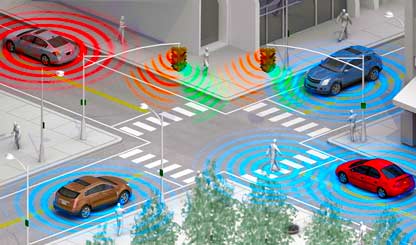
Wireless Pedestrian Detection
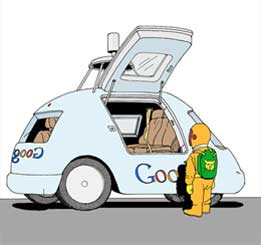
Google Driverless Toyota Again
- Here we see a vintage 1957 H Miller advertisement illustrating a nuclear family enjoying a ride in their autonomous auto. Not only is the vehicle’s computer navigating the highway on its own, it’s doing so with such precision that the family can play a relaxing game of dominoes. Conceivably, the husband takes over driving duties after the vehicle reaches the designated exit ramp.
- General Motors researchers are developing a promising driver assistance feature potentially capable of detecting pedestrians and bicyclists on congested streets or in poor visibility conditions before the driver notices them. It uses peer-to-peer wireless signals. According to the National Highway Traffic Safety Administration, 4,280 US pedestrians and 618 bicyclists lost their lives in collisions with motor vehicles in 2010. This will help.
- The self-driving car is here. But will you feel comfortable putting your child in one?
What to Expect
Ford’s new chief technology director is in the “truly self-driving cars are as much as 10 years away” group. But with the advent of new sensors and always-on Internet connectivity, cars can already do a lot. While driving, sensors in the seat and a camera in the rearview mirror can check the driver’s vital signs, measure his weight, take his temperature, measure his heart rate, and more — delivering those stats to an online medical monitoring system and alerting a doctor (and, on occasion, the authorities) should anything seem out of the ordinary.
Ford has experimented with sensors that make it safer for people who have seizures to drive. A car fitted with sensors detects when the driver begins a seizure, switching into assisted driving mode and heading for a safe parking place. Robotically-driven Ford vehicles currently undergo repeated rigourous tests on Ford tracks whose different surfaces deliberately include broken concrete, cobblestones, metal grates, rough gravel, mud pits, and oversized speed bumps.
In fact, autonomous driving is here, just not legal yet. The Mercedes flagship, the new S-Class, can drive itself. Radar-based distronic systems, short, medium and long range radar, and a stereo camera mounted above the windshield give the car the function of autonomous driving — but that isn’t legally allowed yet. However, in no time you’ll be driving assisted by “someone behind the curtain.” Self-driving cars find their own parking spaces, pick you up in town, talk to the world (and vehicles) around them, to you, and to its primary service centre to schedule maintenance. (The sensors in self-driving cars will provide great opportunities to spot mechanical problems before they happen.)
Sensors can create machine-to-machine data at the rate of 1GB a second — though not much of that data is saved. A car predicts where other vehicles are going and even tries to measure other drivers’ skill. Someday they’ll allow the blind, nearly blind, children, and the aged to have independent mobility. Children can “drive” at a much earlier age (say 8 rather than 16). If a child uses his/her driverless car to get to school, club, gym, and friend’s house once per week, settings wouldn’t allow the car being out after (say) 8pm unless headed for home (there would be only a few set routes). Some experts reckon cars can transform drivers’ lives by allowing them to work or relax as they commute. Thousands of deaths can be avoided by merely controlling the distance between vehicles.
Meanwhile, a little black box records everything. A little-known but increasingly important piece of equipment is buried deep inside a car: the event data recorder, more commonly known as the black box. About 96% of all new vehicles sold in the US have these boxes, and in September 2014, if the National Highway Traffic Safety Administration has its way, all will have them. The boxes have long been used by car companies to assess performance of their vehicles. But data stored in the devices is increasingly used to identify safety problems and as evidence in traffic accident and criminal cases. To federal regulators, law enforcement authorities and insurance companies, black box data is an indispensable tool to investigate crashes. Current regulations require that the presence of the black box be disclosed in the owner’s manual but the vast majority of drivers who don’t read the manual thoroughly may not know that their vehicle can capture and record speed, brake position, seat belt use, and much else — each time they get behind the wheel.
A poll conducted for the Alliance of Automobile Manufacturers said about 75% of US respondents are concerned that companies use the software that controls a self-driving car to collect personal data; 70% are worried that data will be shared with the government. (Alas, this is already happening.) Asked whether they were worried that hackers could gain control of a self-driving vehicle, 81% replied they were either very or somewhat concerned about that threat (probably mistakenly). Advocates of self-driving cars may have work to do explaining the pros and cons of this evolving technology, though Cisco Systems conducted a poll that found that 57% of consumers globally would trust a driverless car, especially in Brazil, India and China. (Interestingly, only 28% of Japanese trusted them.)
Autonomous vehicles may become access points for eager brands, possibly leading to new revenue streams for automakers — in cooperation with advertisers and network providers such as AT&T — that could profit from data collected from passengers. In a web campaign, a retailer at a local mall could sends a self-driving vehicle to a consumer’s home, give the consumer a ride to the store, and then a ride back home. People may accept sales pitches if they get services at discounted rates or even for free. A person could summon a vehicle to take her somewhere for free, but have to sit through advertising she can’t turn off. (This is the model for Pandora Internet Radio, which has a free version with advertisements and a premium ad-free offering.) Also automakers, advertisers who want to reach customers in a vehicle, and network operators such as AT&T all come together to generate revenues through data collection.
One day, I believe self-driving cars will become a standard part of public transit, similar in ways to Zipcar. An entire fleet of cars garaged throughout a city can scheduled daily car pickups or can be order up one by one on demand. You’ll be billed once a month based on usage. Further, cars will ultimately network with everything: traffic lights and signs, even highways; roadwork will advertise itself; cars will adjust automatically to their environment and to each other. New hazards, such as potholes, are marked and shared as soon as any sentient device detects them.
Driverless cars can ultimately erase the need for car ownership — if not the need for cars. How? Perhaps by the subscription model. Instead of buying a single car, sign up for a full range of a car manufacturer’s offering. Planning on taking the family to the mountains for the weekend? An SUV pulls up to your door on command. Need to grab a few groceries? A SmartCar swings by at your convenience. An added benefit of the subscription model? You never worry about parking. There would still be a need for parking of course, though less given declining rates of car ownership.
Self-driving cars aren’t especially effective in getting people places faster on surface streets — they make traffic flow better on freeways. No one supports inefficient freeways — but endeavouring to make car travel effortless feels like a gracious invitation to endless suburban sprawl. If you can read your iPad, enjoy a cocktail, or play a video game while commuting, time spent in the car becomes leisure, something desirable. Long commutes are no longer disincentives. America’s car-dependent culture has been encouraged (and subsidised) usage for the past half-century; instead of bucking that trend, driverless cars make culture remain car-dependent. In 1973, in The Ideology of the Motor Car, French philosopher André Gorz wrote, “The more widespread fast vehicles are within a society, the more time people spend (and lose) on travel. It’s a mathematical fact.” Why? “Ultimately people can’t get around conveniently because they’re so far away from everything.” This observation epitomises the problem of the driverless car. By becoming enamored with how technology might transform the car, we neglect to explore how getting rid of cars might transform us.
Driverless cars can encourage alternate forms of transportation. One reason more folks don’t bike is because they fear being hit by a car. Driverless cars reduce that risk significantly. And the technology makes maintaining street-level public transportation cheaper for communities as there are no pension obligations for a driverless bus. Insurance companies will offer premium differentials favouring driverless vehicles. State governments will offer differential registration fees. Finally, everybody (save wealthy enthusiasts who can afford to avoid it) will have new driverless vehicles. Forget whether you like it or not, you’ll have no choice. Machine-driven trucks run safely 24 hours a day. Shipping costs by truck reduce while social costs go up owing to those newly-unemployeds with now-outdated skills (now viewed as worthless).
Giant retailers with a core competence in managing complex distribution channels or fleet providers who can manage the complexity of renting and allocating fleets will enter the fray and accrue a significant value in this new ecosystem. New entrants in the market might compete at either end of a spectrum — generic, low-cost utilitarian transportation-on-demand is at one end (the low-cost airline model), and super-luxury mobile executive suites and sleeping pods are at the other (the first class or private jet experience). Success is determined by efficiency, reliability, flexibility, maintenance, customer service, ease of interface, and integration with existing devices — plus other psychographic factors that determine consumer behaviours and brand preference.
Acceptance
Driverless cars reduce car insurance, will be able to drive in fog, and won’t get distracted. They’ll increase the number of trips taken, decrease public mass transit, and increase commute times. Perhaps a few people will live in their cars, applying their rent money to fuel. Whatever. Driverless cars WILL happen (are already happening). Why fret? Welcome the change (it’s here regardless).
Change is the law of life.
Those who look only to the past or present are certain to miss the future.
— John F Kennedy
Sources:
Everything Else
Death Valley, California USA


Little Sandy Desert, Australian Outback

Iranian Lut at Ground Level

Death Valley Charcoal Kilns
- Commander Hadfield says he stayed up late one night in April to catch the morning light on the artwork that is the outback. The term “the outback” is generally used to refer to locations that are comparatively more remote than those areas named “the bush” which, colloquially, can refer to any lands outside the main urban areas. While the early explorers used horses to cross the outback, the first woman to make the journey riding a horse was Anna Hingley, who rode from Broome to Cairns … in 2006.
- The Lut Desert is in Iran northwest of Kerman. It contains several ancient interior drainage systems separated by low ridges and residual mountains. Alternating wet and dry periods coupled with tectonic compression of the basin fill sediments into scarcely perceptible folds, resulted in unusual types of relief called yardangs (streamlined hills carved from bedrock or any consolidated or semi-consolidated material by the dual action of wind abrasion, dust and sand). The yardangs of the western Lut Desert (see Google Maps 30° 35’ 38.78” N, 58° 16’ 0.25” E for a wide satellite view) are up to 80 metres high, among the largest on Earth. They have an estimated thickness of 135 to 200 metres. Salt, gypsum, and silty clay encrust them. These yardangs have been described as resembling desert cities separated by “boulevards.” They parallel the prevailing winds and are separated by 100 metres or more of troughs.
- Death Valley from the space station looks every inch of its name. It is the lowest, hottest and driest area in North America. The white areas are sodium salt and borax. The hottest air temperature ever recorded in Death Valley was 134°F (57°C) on 10 July 1913.
- Triodia is a large genus of hummock-forming grass endemic to Australia; they are commonly known as spinifex, although they aren’t a part of the coastal genus Spinifex. There are currently 64 recognised species; it’s a perennial Australian grass which grows in arid regions and has awl-shaped, pointed leaves whose leaf tips (high in silica) can break off in the skin, leading to severe infections (just one more way Australia can kill you). Leaves are 30-40 centimetres long. This is triodia basedowii. It provides a good home for many desert lizards, snakes, birds and small mammals.
- I would guess that it has been a considerable number of years since this area of Iran experienced a “wet” period. This is often the warmest place on Earth.
- These are the Wildrose charcoal kilns in the Panamint Range, Death Valley National Park, California, USA. They were were built in 1867 and ceased operation in 1879. They used pinyon and juniper tree wood to make charcoal in a process of slow burning in low oxygen. This fuel was then transported to mines in Death Valley to feed smelting and ore extraction operations. At around 6,800 feet, they are considered to be the best preserved of their kind in the western states, perhaps due to their remote location. It took 42 cords of wood to fill each of the 10 kilns. After a week of burning and a few more days of cooling, each cord would have produced about 45 to 50 bushels of charcoal — or about 2,000 bushels of charcoal per kiln. It took a team of about 40 woodcutters to keep the kilns supplied with wood, which was cut and carried or skidded from the surrounding area.

Asiago in a Fairy Tale Fog

A Descent into the Maelström
- The country of Conco (a district of Lusiana) shrouded in mist, taken from the Seven Municipalities Plateau. The Seven Communities were a group of municipalities in the Veneto region that spoke the Cimbrian language, a dialect of Upper German, as their native tongue. The municipalities are located on a high plateau northwest of Vicenza. They consist of: Asiago, Gallio, Roana, Foza, Enego, Rotzo, and Lusiana. Conco is a town in the province of Vicenza, Veneto, Italy. Nearby, at the top of the Leiten Hills is the hovering shadow of the Military Shrine, where lie the graves of approximately 54,000 soldiers killed in a fierce battle in World War I.
- During a cloudless twilight, just before sunrise or after sunset, part of the atmosphere above the horizon appears slightly off-colour, slightly pink. Called the Belt of Venus, this band between the dark eclipsed sky and the blue sky can be seen in nearly every direction including opposite the sun. Straight above, blue sky is normal sunlight reflecting off the atmosphere. In the Belt of Venus, however, the atmosphere reflects light from the setting (or rising) sun which appears more red. It can be seen from any location with a clear horizon. This one was photographed above morning fog in the Valley of the Moon, a famous wine-producing region in northern California, USA.
- The bell tower of San Luca di Marostica, Vicenza foothills (the name means “that has mountains and hills”).

Nervous over His First Dance
- Actually, I think he’s supposed to be watching squirrels. I prefer to pretend he’s faithfully waiting for his master to return.
- Swans are not known to attack humans without cause, and actually can remember people that have been kind to them. Like other swans, the Black Swan is largely monogamous, pairing for life (with a divorce rate of about 6%). However, recent studies have shown that around a third of all broods exhibit extra-pair paternity. An estimated one-quarter of all pairings are homosexual, mostly between males. They steal nests, or form temporary threesomes with females to obtain eggs, then drive the female away afterward.
- This photo was labelled The Great Catsby after a very popular Korean cartoon, though looks nothing like him.
Remarkable in Black and White
I browsed through several humdred photos of photographer Brian Day and came up with these 3 that I thought were representative of his unusual talent. He has an eye for framing and especially lighting. I have only two criticisms: his portfolio has a bit too much repetition — meaning I had to look through twice as many photos as I would’ve liked. I feel he should highgrade his Flickr presentation a bit. Also, I would like more detail about photo content as I sometimes wasn’t sure what I was seeing. I gather he lives in or near Detroit.

Boat Hotel Cocoa Island, the Maldives
- Photographed by the Fireman’s Wife, Bea Doe.
- Conveniently situated 30 minute from the Male Airport, this stunning boat hotel at the Cocoa Island Maldives offers “gym, internet access, restaurants, bar, spa, swimming pool, and of course being suspended over the beautiful clear waters of the Indian Ocean. (Actually, you aren’t exactly “suspended” — according to their website, the suite doesn’t float but is rather fixed to the lagoon bed. Since I thought the gentle motion caused by the water would be its biggest selling point, I was a bit disappointed.)
- A long, long time ago, in 1859, there was a dwarf. The dwarf discerned a plot about a kitten invasion coming over the mountain to take over the land. The dwarf, due to his extraordinary bravery, defeated the kitten army in a great battle. (How? He tickled their leader so much he died laughing.) Or is this actually a short story about the Dwarf Fortress game played by a Chinese t-shirt factory worker, who poorly machine-translated it onto a t-shirt? On the other hand, it could be the harbinger of the impending apocalypse…
 Animals
Animals Animation
Animation Art of Playing Cards
Art of Playing Cards Drugs
Drugs Education
Education Environment
Environment Flying
Flying History
History Humour
Humour Immigration
Immigration Info/Tech
Info/Tech Intellectual/Entertaining
Intellectual/Entertaining Lifestyles
Lifestyles Men
Men Money/Politics/Law
Money/Politics/Law New Jersey
New Jersey Odds and Oddities
Odds and Oddities Older & Under
Older & Under Photography
Photography Prisons
Prisons Relationships
Relationships Science
Science Social/Cultural
Social/Cultural Terrorism
Terrorism Wellington
Wellington Working
Working Zero Return Investment
Zero Return Investment